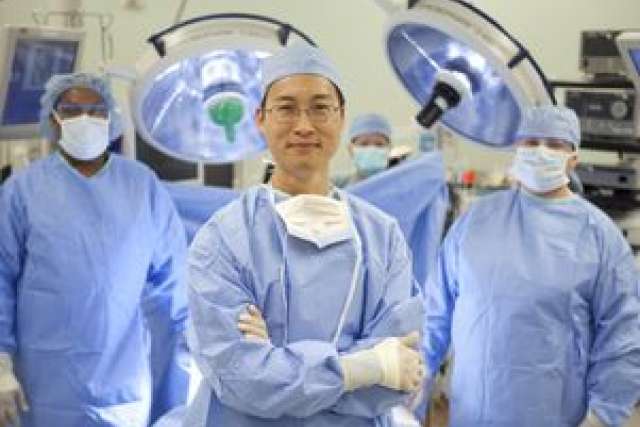Grants made by UC’s Center for Health Quality and Innovation to fund innovative projects that improve patient care and satisfaction at UC hospitals are paying off with positive results, including fewer blood clots and better post-surgical care at UC hospitals.
Based on current cost savings, revenues and additional funds received, according to a new report, the projected net financial gain in 2016 of the center’s 50 grants will be about $40 million from a $7.3 million allocation from UC medical centers — a return on investment of more than 5 to 1.
“The investment has been a good one,” said Dr. John Stobo, UC Health senior vice president and chairman of the Center for Health Quality and Innovation (CHQI). “The innovation center has done a lot of good in terms of improving quality and saving costs.”
One example of an initiative that has paid off with net revenues of more than $800,000 per month is a UCLA elective surgery discharge program that has made the patient discharge process much more efficient and gets patients being discharged by their doctors out of the hospital faster and with a better understanding of how to take their post-surgery medication, said Dr. Michael Yeh, associate professor of surgery at UCLA. He worked with an interdisciplinary team at Reagan UCLA Medical Center, where there is a constant demand for beds, to examine every step in the discharge process, identify logjams that were clogging up the system and then expediting it.
One major improvement was reducing the time it took for patients to get their discharge medication, said Yeh, who collaborated with pharmacists Kerry MenMuir and Diane Zalba. To do this, the hospital set up a specific pharmacy with dedicated staff to fill discharge prescriptions submitted online for post-surgery patients. Now physicians’ orders can be filled and delivered to a patient’s bedside in roughly 45 minutes by the pharmacy staff, who can then instruct patients on how to take their medicine and answer any questions. A handheld device is used to swipe the patient’s credit card to cover any co-payments.
“Think of all the many ways we’ve won,” Yeh said. “It’s more efficient because the patient goes home sooner. It lowers our costs and increases our virtual bed capacity. You may have the same number of physical beds, but if you use them more efficiently, it defacto increases the size of your hospital.
“You’re also making sure the patient is getting the correct medication, the patient gets educated, and they benefit from a great service,” the surgeon said. Additionally, it lowers the risk of a patient becoming readmitted because of a mistake in taking medication. Among those who benefit the most from this service are transplant patients, cancer patients and older patients, he said.
The Center for Health Quality and Innovation was established in 2010 to foster innovations developed at UC medical center campuses and hospitals in order to improve quality, access and value in the delivery of health care. In addition to funding from UC’s five medical centers, the center has allocated $7.7 million from the UC Office of Risk Services for grants designed to reduce the risk of clinical harm to UC patients.
“We’ve been able to support innovative projects that produce better outcomes for patients, reduce costs and are being expanded across the UC Health system,” said Karyn DiGiorgio, the center’s executive director. “This report helps quantify our impact.”
Other examples include:
- A five-campus project to reduce dangerous blood clots (venous thromboembolism, or VTE) prevented an estimated 140 VTE occurrences in 2013 for an annual savings of $1.45 million.
- A project at UC Irvine reduced the median length of stay for high-risk abdominal surgery patients by two days, resulting in fewer complications and projected annual savings of $816,000.
- The 2012 UC San Diego colorectal postoperative program reduced the length of a patient's stay by 4.5 days for high-risk surgical patients and 0.9 days for moderate-risk patients, resulting in projected annual savings of $553,000.
- A 2012 UCSF palliative care intervention resulted in 45 additional palliative care consults in the intensive care unit, generating $167,000 in annual savings from reduced ICU bed-days.
- A 2012 UC Davis specialty pharmacy initiative led to contracts that generated $18,000 in revenue at UC Davis and $1.36 million in revenue at UCSF during a CHQI fellowship.
The report projects at least $25 million in grant-generated cost savings and revenues by the end of 2016. Also, seven project teams have received an additional $16 million in external funding based on their CHQI work. In addition, 16 papers in national journals have been published based on work funded by the center.
The report was prepared by the center’s Innovation Evaluation Committee, which includes Michael Ong of UCLA, Patrick Romano of UC Davis, Andrew Auerbach of UCSF, Sheldon Greenfield of UC Irvine, Theodore Ganiats of UC San Diego, Stephen Shortell of UC Berkeley and DiGiorgio. The center plans to issue a yearly update and expects to present by 2016 an in-depth review of the overall impact of the programs funded by the center.
This story was adapted from one that is posted on the UC Health website.
Alec Rosenberg



